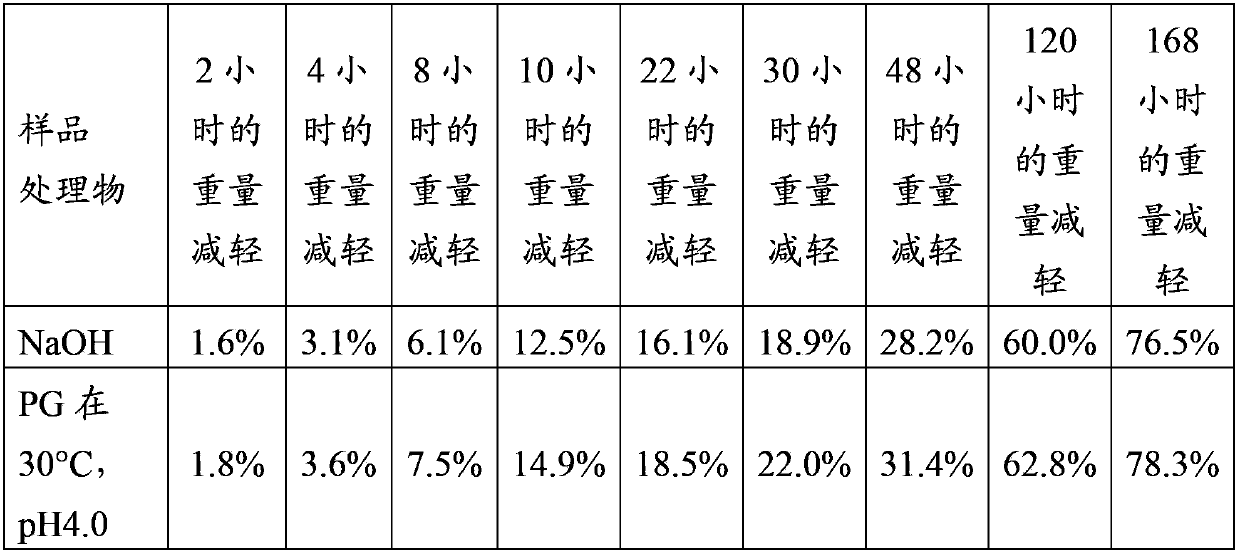Enzymatic pretreatment for making dried fruits
A technology of enzyme treatment and pretreatment, applied in food preparation, application, preservation of fruits/vegetables by dehydration, etc., can solve problems such as microbial deterioration and fading
- Summary
- Abstract
- Description
- Claims
- Application Information
AI Technical Summary
Problems solved by technology
Method used
Image
Examples
Embodiment 1
[0080] Example 1: Pretreatment of grapes with polygalacturonase
[0081] 100 g of grapes (green grapes originating in China) were added to the following 5 beakers.
[0082] Group 1: 100 g of grapes were added to 200 ml of NaOH solution with a NaOH concentration of 15 g / l and a solution pH of 13.0.
[0083] Group 2: 100 g of grapes were added to 200 ml of citrate buffer (pH 4.0, 50 mM).
[0084] Group 3: Prepare 200 ml of a stock solution of 0.2% (w / w) low PG concentration citrate buffer (pH 4.0, 50 mM). To this solution was added 100 g of grapes.
[0085]Group 4: Prepare 200 ml of a stock solution (pH 4.0, 50 mM) of citrate buffer with a high PG concentration of 0.4% (w / w). To this solution was added 100 g of grapes.
[0086] Grapes from groups 2, 3 and 4 were macerated for 30 minutes at 50°C. According to the industrial raisin production process, the grapes in group 1 were soaked at room temperature for 30 seconds. All grapes were then removed from the beakers, dried ...
Embodiment 2
[0091] Example 2: Pretreatment of grapes with polygalacturonase at different pH and temperature
[0092] 100 g of grapes (purple grapes from China) were added to the following four beakers.
[0093] Group 1: 100 g of grapes were added to 200 ml of NaOH solution with a concentration of 15 g / l.
[0094] Group 2: Prepare 200 ml of a stock solution of citrate buffer (pH 4.0, 50 mM) at a PG concentration of 0.2% (w / w). To this solution was added 100 g of grapes.
[0095] Group 3: Prepare 200 ml of a stock solution of citrate buffer (pH 5.5, 50 mM) at a PG concentration of 0.2% (w / w). To this solution was added 100 g of grapes.
[0096] Group 4: Prepare 200 ml of a stock solution of citrate buffer (pH 6.5, 50 mM) at a PG concentration of 0.2% (w / w). To this solution was added 100 g of grapes.
[0097] The grapes in Group 2 were macerated at 30°C for 30 minutes, and the grapes in Groups 3 and 4 were macerated at 50°C for 30 minutes. The grapes of Group 1 were soaked for 30 se...
Embodiment 3
[0102] Example 3: Pretreatment of grapes with polygalacturonase and pectinesterase
[0103] 100 g of grapes (purple grapes originating in China) were added to the following 2 beakers.
[0104] Group 1: 100 g of grapes were added to 200 ml of NaOH solution with a concentration of 15 g / l.
[0105] Group 2: Prepare 200 ml of a stock solution (pH 4.0, 50 mM) of citrate buffer with a PG concentration of 0.15% (w / w) and a PE concentration of 0.05% (w / w). To this solution was added 100 g of grapes.
[0106] The grapes in Group 2 were soaked for 30 minutes at 50°C. The grapes of Group 1 were soaked for 30 seconds at room temperature following the industrial process for raisin production. All grapes were then removed from the beakers, dried in an oven at 45°C, and weighed at intervals of several hours to determine weight loss. The weight loss results are given in Table 3.
[0107] Table 3: Weight loss during drying
[0108]
[0109]
[0110] For the grapes treated with th...
PUM
 Login to View More
Login to View More Abstract
Description
Claims
Application Information
 Login to View More
Login to View More - R&D
- Intellectual Property
- Life Sciences
- Materials
- Tech Scout
- Unparalleled Data Quality
- Higher Quality Content
- 60% Fewer Hallucinations
Browse by: Latest US Patents, China's latest patents, Technical Efficacy Thesaurus, Application Domain, Technology Topic, Popular Technical Reports.
© 2025 PatSnap. All rights reserved.Legal|Privacy policy|Modern Slavery Act Transparency Statement|Sitemap|About US| Contact US: help@patsnap.com



